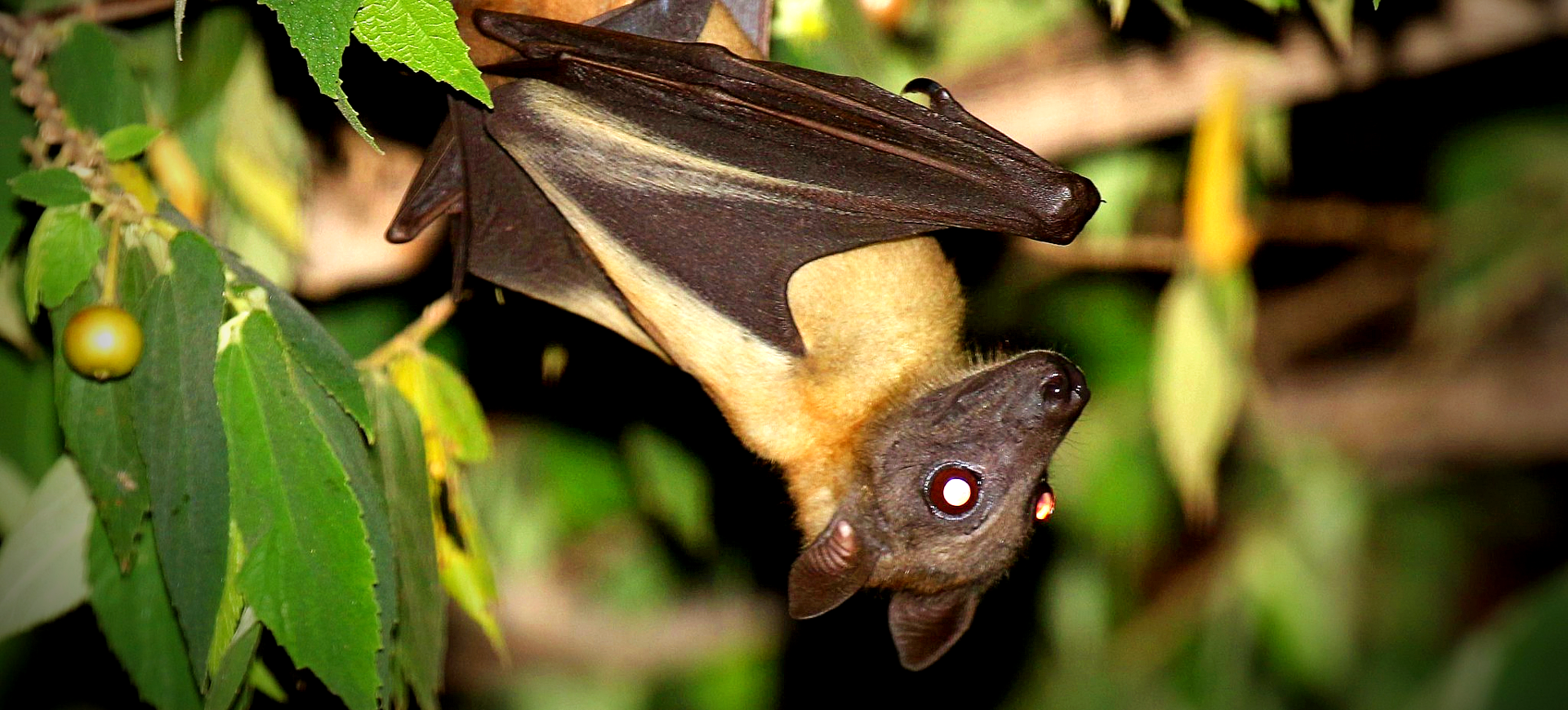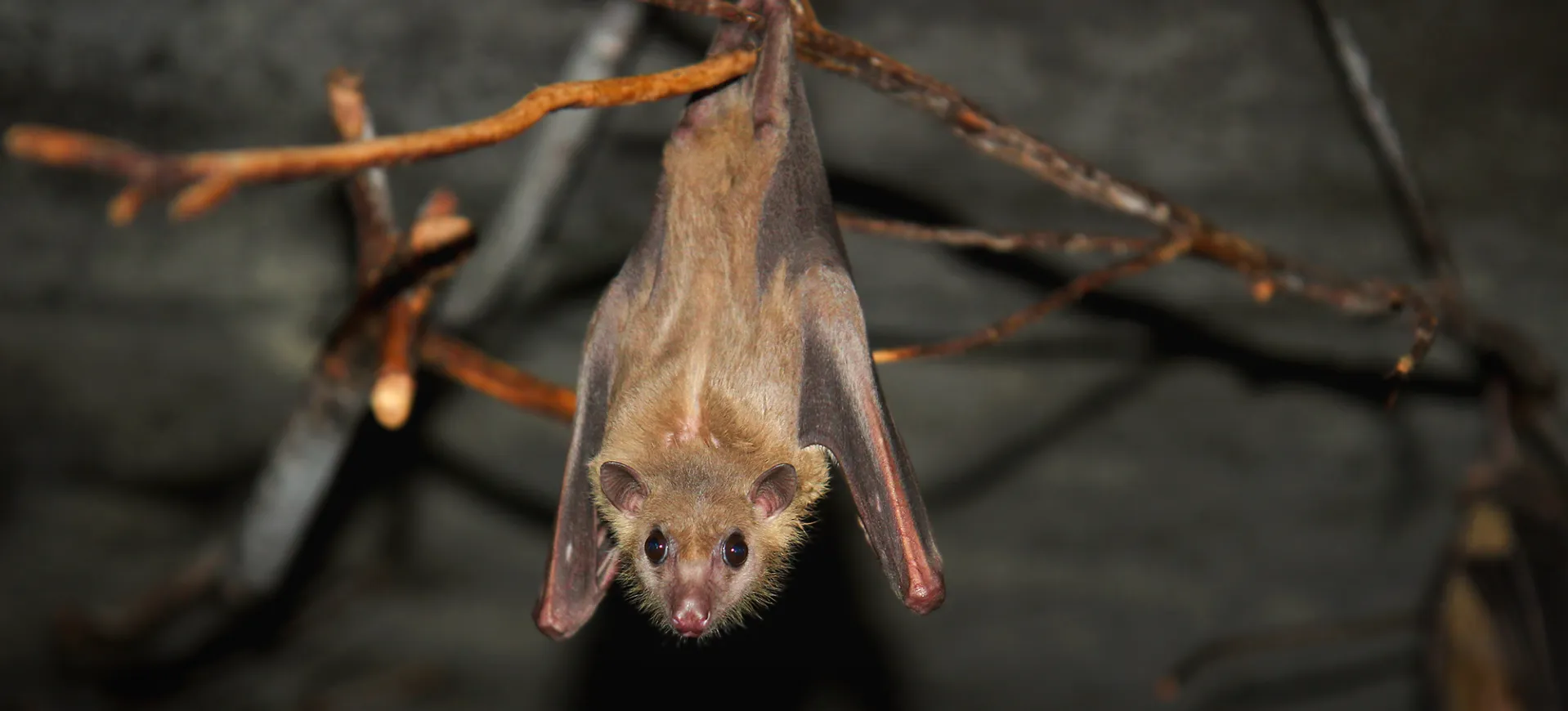Overview
The Indian Flying Fox, also known as the Greater Indian Fruit Bat, is one of the largest bat species in the world. It is native to the Indian subcontinent and parts of Southeast Asia. Characterized by its large wingspan and distinctive fox-like face, this species primarily feeds on fruits, making it an essential seed disperser in its ecosystem.
The Indian Flying Fox is a highly social species that forms large colonies, often roosting in tall trees near water bodies. These colonies can consist of hundreds to thousands of individuals. The species is diurnal and crepuscular, meaning it is most active during the day and at twilight, which is unusual for bats.
The Indian Flying Fox plays a vital role in its ecosystem by pollinating flowers and dispersing seeds. However, it is often considered a pest by fruit farmers and hunted for its meat and perceived medicinal properties. As a result, the species faces various threats, including habitat loss and hunting, necessitating conservation efforts.
Taxonomy
Kingdom
Phylum
Class
Order
Family
Genus
Species
Type
Physical Description:
The Indian Flying Fox is a large bat species with a wingspan exceeding 4 feet. It has a reddish-brown fur coat and a fox-like face, which gives it its common name. The species lacks the echolocation abilities of many other bats and relies on its keen eyesight and sense of smell to locate food.
The wings of the Indian Flying Fox are long and pointed, allowing for efficient flight. The species has a robust build, with males generally larger than females. The large eyes are adapted for low-light conditions, aiding navigation during twilight hours when the bat is most active.

Lifespan: Wild: ~15 years || Captivity: ~20 years

Weight: Male: 1.1–3.3 lbs (0.5–1.5 kg) || Female: 1.1–2.6 lbs (0.5–1.2 kg)

Length: Male: 12–15 in (30–38 cm) || Female: 11–14 in (28–36 cm)

Wingspan: Male & Female: 3.9–4.9 ft (1.2–1.5 m)
Characteristic:
Native Habitat:
The Indian Flying Fox is native to the Indian subcontinent, including India, Bangladesh, Sri Lanka, and parts of Pakistan. It prefers to roost in tall trees near water bodies such as rivers and lakes. The species is highly adaptable and can also be found in urban areas, where it often roosts in large trees in parks and gardens.
The species faces threats from habitat loss due to deforestation and human encroachment. It is also often persecuted as a pest by fruit farmers, who consider it a threat to their crops. Despite these challenges, the Indian Flying Fox is currently listed as “Least Concern” by the IUCN, although localized populations may be at risk.
Biomes:
Biogeographical Realms:
Continents:
Diet:
Diet & Feeding Habits:
The Indian Flying Fox primarily feeds on fruits such as mangoes, bananas, and guavas. It uses its keen sense of smell and eyesight to locate ripe fruits. Once a suitable fruit is found, the bat will often carry it to a preferred roosting spot to consume it, discarding the seeds and aiding in seed dispersal.
The species also feeds on nectar and flower parts, contributing to pollination. The Indian Flying Fox is known to cover large distances for food, often flying several kilometers in a single night. It is most active during the twilight hours, although it can also be seen foraging during the day.
Mating Behavior:
Mating Description:
The Indian Flying Fox has a polygynous mating system, where a single male mates with multiple females. Mating usually occurs between July and October, and females give birth to a single pup after a gestation period of about 140–150 days. The young are born well-developed and cared for by the mother until they can fly and forage independently.
During the mating season, males engage in displays to attract females, including vocalizations and wing-flapping. Once a female is receptive, the male will guard her to prevent other males from mating. The mother carries the pup for the first few weeks, leaving it in the roost while the mother forages, returning periodically to nurse.
Reproduction Season:
Birth Type:
Pregnancy Duration:
Female Name:
Male Name:
Baby Name:
Social Structure Description:
The Indian Flying Fox is a highly social species that forms large colonies, often consisting of hundreds to thousands of individuals. These colonies are usually found roosting in tall trees near water bodies. The colony has a loose hierarchy, with dominant males occupying the prime roosting spots.
Social interactions within the colony include grooming and vocalizations, strengthening social bonds. The species is known for its complex social behaviors, including food sharing and cooperative care of young. This social structure is crucial for the survival of the Indian Flying Fox, as it provides protection against predators and helps in efficient foraging.
Groups:
Conservation Status:
Population Trend:
The Indian Flying Fox is currently listed as “Least Concern” by the IUCN, but its population is decreasing due to various threats. The species is often hunted for its meat and traditional medicine and is also persecuted as a crop pest. Habitat loss due to deforestation and human encroachment further exacerbates these threats.
Despite its challenges, the Indian Flying Fox plays a crucial role as a pollinator and seed disperser in its ecosystem. Conservation efforts include habitat protection and public awareness campaigns to reduce human-wildlife conflict. Legal protection exists, but enforcement is often inadequate, making community involvement and education key to the species’ survival.
Population Threats:
The primary threats to the Indian Flying Fox include habitat loss, hunting, and persecution as a crop pest. Deforestation and human encroachment have led to a loss of natural roosting and foraging sites. Despite legal protections, the species is also hunted for its meat and traditional medicine.
Human-wildlife conflict is another significant issue, particularly in agricultural areas where the Indian Flying Fox is a pest. Farmers often resort to culling or using harmful chemicals to deter the bats, leading to further population declines. Public awareness and education are crucial for mitigating these threats and promoting coexistence.
Conservation Efforts:
Conservation strategies for the Indian Flying Fox include habitat protection and community-based initiatives. Several protected areas have been established within the species’ range to safeguard its natural habitat. Additionally, educational programs are being implemented to raise awareness about the importance of conserving this unique species.
Community-based conservation programs are also in place, encouraging local communities to participate in conservation efforts. These programs aim to mitigate human-wildlife conflicts by promoting sustainable agricultural practices and providing alternative livelihoods. Ongoing monitoring and research are crucial for adapting conservation strategies to the changing needs of the Indian Flying Fox population.
Additional Resources:
Fun Facts
- The Indian Flying Fox is one of the largest bat species in the world, with a wingspan that can exceed 4 feet.
- The species is a key pollinator and seed disperser in its ecosystem.
- Unlike many other bat species, the Indian Flying Fox is diurnal and crepuscular.
- The species forms large colonies, often hundreds to thousands of individuals.
- The Indian Flying Fox is highly adaptable and can be found in various habitats, including urban areas.
- The species has a polygynous mating system, with one dominant male mating with multiple females.
- The Indian Flying Fox is known for its complex social behaviors, including food sharing and cooperative care of the young.
- Despite being a key species in its ecosystem, the Indian Flying Fox is often considered a pest by fruit farmers.
- The species is currently listed as “Least Concern” by the IUCN but faces various threats, including habitat loss and hunting.
- The Indian Flying Fox can cover large distances for food, often flying several kilometers in a single night.








